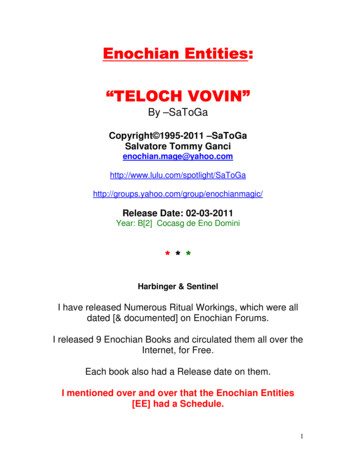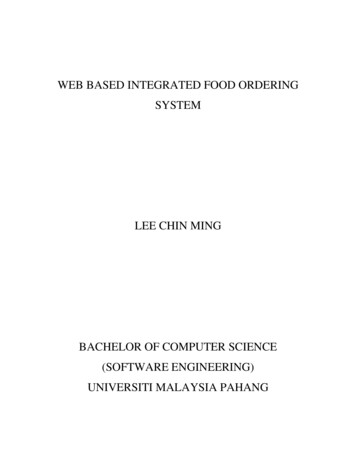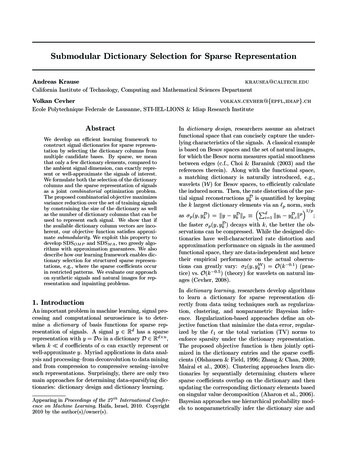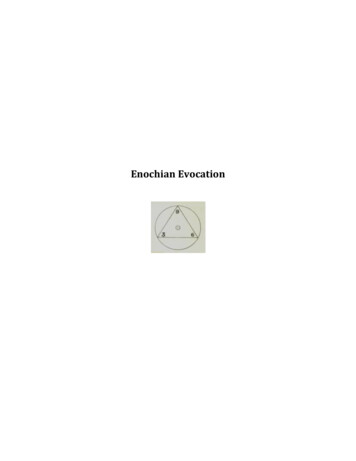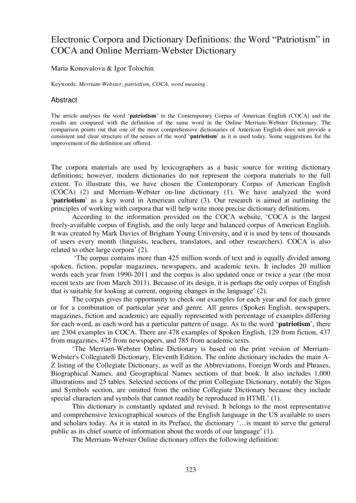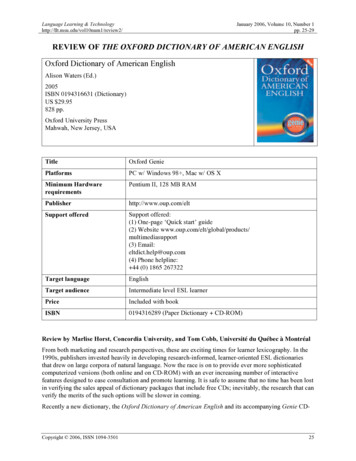
Transcription
The Whole Enochian Dictionary
IntroductionDo what thou wilt shall be the whole of the Law.The Grand Experiment in the Enochian language is begun. Using etymological and qabalistic techniques to solvesome of the mysteries of this language has proven to be highly rewarding. Starting off this Enochian Dictionary,we’ve downloaded a host of information from Wikipedia in order to educate and prepare the reader for thecreative process that is to follow. Large examples of the techniques used to create this word can be found in theAOM’s translations of Liber Loagaeth and further detailed in Liber Ged; of AOM origin.We’ve also included Aaron Lietch’s excellent essay on the Enochian language and Patricia Shaffer’s LetterEssences in order to create a more complete compendium for the serious student of this language.The Problem of the Schuelers TranslationThe Holy Table of Practice has been translated previously by published authors whose works are infamouslyriddled with errors. There is no worse example of this than the translations of the Holy Table and Table of 12.Here the Schuelers literally make up definitions for words without any rationale at all; as if they’re inventing theirown game. This is really no worse than the creative yet, ridiculous efforts of the Golden Dawn to “truncate” thesquares of the Elemental Tablets. And these irrational efforts only confound the effectiveness of this Magick.The translations here have been carefully produced by strict etymological and qabalistic practices outlinedin the AOM’s Liber Ged and as well, the production in Liber Loagaeth. And unlike the Schuelers, greatcare has been taken to explain how these translations have been produced, that the thorough student canclaim confidence in his or her findings in this work.Love is the law, love under will.
Enochian GrammarLinguistics is the scientific study of language, which can be theoretical or applied. Someone who engages in thisstudy is called a linguist.Theoretical (or general) linguistics encompasses a number of sub-fields, such as the study of language structure(grammar) and meaning (semantics). The study of grammar encompasses morphology (formation and alterationof words) and syntax (the rules that determine the way words combine into phrases and sentences). Also a part ofthis field are phonology, the study of sound systems and abstract sound units, and phonetics, which is concernedwith the actual properties of speech sounds (phones), non-speech sounds, and how they are produced andperceived.Linguistics compares languages (comparative linguistics) and explores their histories, in order to find universalproperties of language and to account for its development and origins (historical linguistics).Theoretical linguistics is the branch of linguistics that is most concerned with developing models of linguisticknowledge. Part of this endeavor involves the search for and explanation of linguistic universals, that is,properties all languages have in common. The fields that are generally considered the core of theoreticallinguistics are syntax, phonology, morphology, and semantics. Although phonetics often informs phonology, it isoften excluded from the purview of theoretical linguistics, along with psycholinguistics and sociolinguistics.A linguistic universal is a statement that is true for all natural languages. For example, All languages have nounsand verbs, or All spoken languages have consonants and vowels. Research in this area of linguistics is closely tiedto linguistic typology, and intends to reveal information about how the human brain processes language. The fieldwas largely pioneered by the linguist Joseph Greenberg, who from a set of some thirty languages derived a set ofbasic universals, mostly dealing with syntax.Linguistic typology is a subfield of linguistics that studies and classifies languages according to their structuralfeatures. Its aim is to describe and explain the structural diversity of the world's languages. It includes threesubdisciplines: Qualitative typology deals with the issue of comparing languages and within-language variance,Quantitative typology deals with the distribution of structural patterns in the world’s languages, and Theoreticaltypology explains these distributions.In linguistics, syntax (from Ancient Greek συν- syn-, “together”, and τάξις táxis, “arrangement”) is the study ofthe rules that govern the structure of sentences, and which determine their relative grammaticality. The termsyntax can also be used to refer to these rules themselves, as in “the syntax of a language”. Modern research insyntax attempts to describe languages in terms of such rules, and, for many practitioners, to find general rules thatapply to all languages. Since the field of syntax attempts to explain grammaticality judgments, and not providethem, it is unconcerned with linguistic prescription.Though all theories of syntax take human language as their object of study, there are some significant differencesin outlook. Chomskian linguists see syntax as a branch of psychology, since they conceive syntax as the study oflinguistic knowledge. Others (e.g. Gerald Gazdar) take a more Platonistic view, regarding syntax as the study ofan abstract formal system.Phonology (Greek φωνή (phōnē), voice, sound λόγος (lógos), word, speech, subject of discussion), is asubfield of linguistics which studies the sound system of a specific language (or languages). Whereas phonetics isabout the physical production and perception of the sounds of speech, phonology describes the way soundsfunction within a given language or across languages.
An important part of phonology is studying which sounds are distinctive units within a language. In English, forexample, /p/ and /b/ are distinctive units of sound, (i.e., they are phonemes / the difference is phonemic, orphonematic). This can be seen from minimal pairs such as "pin" and "bin", which mean different things, but differonly in one sound. On the other hand, /p/ is often pronounced differently depending on its position relative toother sounds, yet these different pronunciations are still considered by native speakers to be the same "sound". Forexample, the /p/ in "pin" is aspirated while the same phoneme in "spin" is not. In some other languages, forexample Thai and Quechua, this same difference of aspiration or non-aspiration does differentiate phonemes.In addition to the minimal meaningful sounds (the phonemes), phonology studies how sounds alternate, such asthe /p/ in English described above, and topics such as syllable structure, stress, accent, and intonation.The principles of phonological theory have also been applied to the analysis of sign languages, even though thephonological units are not acoustic. The principles of phonology, and for that matter, language, are independent ofmodality because they stem from an abstract and innate grammar.Morphology is the field within linguistics that studies the internal structure of words. (Words as units in thelexicon are the subject matter of lexicology.) While words are generally accepted as being (with clitics) thesmallest units of syntax, it is clear that in most (if not all) languages, words can be related to other words by rules.For example, English speakers recognize that the words dog, dogs, and dog-catcher are closely related. Englishspeakers recognize these relations from their tacit knowledge of the rules of word-formation in English. Theyintuit that dog is to dogs as cat is to cats; similarly, dog is to dog-catcher as dish is to dishwasher. The rulesunderstood by the speaker reflect specific patterns (or regularities) in the way words are formed from smallerunits and how those smaller units interact in speech. In this way, morphology is the branch of linguistics thatstudies patterns of word-formation within and across languages, and attempts to formulate rules that model theknowledge of the speakers of those languages.Semantics (Greek sēmantikos, giving signs, significant, symptomatic, from sēma (σῆμα), sign) refers to theaspects of meaning that are expressed in a language, code, or other form of representation of information.Semantics is contrasted with two other aspects of meaningful expression, namely, syntax, the construction ofcomplex signs from simpler signs, and pragmatics, the practical use of signs by agents or communities ofinterpretation in particular circumstances and contexts. By the usual convention that calls a study or a theory bythe name of its subject matter, semantics may also denote the theoretical study of meaning in systems of signs.Though terminology varies, writers on the subject of meaning generally recognize two sorts of meaning that asignificant expression may have: (1) the relation that a sign has to objects and objective situations, actual orpossible, and (2) the relation that a sign has to other signs, most especially the sorts of mental signs that areconceived of as concepts.Most theorists refer to the relation between a sign and its objects, as always including any manner of objectivereference, as its denotation. Some theorists refer to the relation between a sign and the signs that serve in itspractical interpretation as its connotation, but there are many more differences of opinion and distinctions oftheory that are made in this case. Many theorists, especially in the formal semantic, pragmatic, and semiotictraditions, restrict the application of semantics to the denotative aspect, using other terms or completely ignoringthe connotative aspect.Phonetics (from the Greek word φωνή, phone meaning 'sound, voice') is the study of the sounds of humanspeech. It is concerned with the actual properties of speech sounds (phones), and their production, audition andperception, as opposed to phonology, which is the study of sound systems and abstract sound units (such asphonemes and distinctive features). Phonetics deals with the sounds themselves rather than the contexts in whichthey are used in languages. Discussions of meaning (semantics) do not enter at this level of linguistic analysis.
Phonetics has three main branches: articulatory phonetics, concerned with the positions and movements of the lips, tongue, vocal tract andfolds and other speech organs in producing speech; acoustic phonetics, concerned with the properties of the sound waves and how they are received by theinner ear; and auditory phonetics, concerned with speech perception, principally how the brain forms perceptualrepresentations of the input it receives.There are over a hundred different phones recognized as distinctive by the International Phonetic Association(IPA) and transcribed in their International Phonetic Alphabet.Phonetics was studied as early as 2,500 years ago in ancient India, with Pāṇini's account of the place and mannerof articulation of consonants in his 5th century BCE treatise on Sanskrit. The major Indic alphabets today, exceptTamil script, order their consonants according to Pāṇini's classification.Psycholinguistics or psychology of language is the study of the psychological and neurobiological factors thatenable humans to acquire, use, and understand language. Initial forays into psycholinguistics were largelyphilosophical ventures, due mainly to a lack of cohesive data on how the human brain functioned. Modernresearch makes use of biology, neuroscience, cognitive science, and information theory to study how the brainprocesses language. There are a number of subdisciplines; for example, as non-invasive techniques for studyingthe neurological workings of the brain become more and more widespread, neurolinguistics has become a field inits own right.Psycholinguistics covers the cognitive processes that make it possible to generate a grammatical and meaningfulsentence out of vocabulary and grammatical structures, as well as the processes that make it possible tounderstand utterances, words, text, etc. Developmental psycholinguistics studies infants' and children's ability tolearn language, usually with experimental or at least quantitative methods (as opposed to naturalistic observationssuch as those made by Jean Piaget in his research on the development of children).Sociolinguistics is the study of the effect of any and all aspects of society, including cultural norms, expectations,and context, on the way language is used. Sociolinguistics overlaps to a considerable degree with pragmatics.It also studies how lects differ between groups separated by certain social variables, e.g., ethnicity, religion,status, gender, level of education, etc., and how creation and adherence to these rules is used to categorizeindividuals in social class or socio-economic classes. As the usage of a language varies from place to place(dialect), language usage varies among social classes, and it is these sociolects that sociolinguistics studies.The social aspects of language was in the modern sense first studied by Indian and Japanese linguists in the1930s, but did not receive much attention in the West until much later. Sociolinguistics in the west first appearedin the 1960s and was pioneered by linguists such as William Labov in the US and Basil Bernstein in the UK.Grammar is the study of rules governing the use of language. The set of rules governing a particular language isthe grammar of that language; thus, each language can be said to have its own distinct grammar. Note that theword grammar has two meanings here: the first is the inner rules themselves and the second is our description andstudy of those rules. When a grammar is fully explicit about all possible construction of a specific language it iscalled generative grammar. A particular type of generative grammar that has become the leading framework inmodern linguistics is transformational grammar which was first proposed by Noam Chomsky.
Grammar is part of the general study of language called linguistics. Grammar is a way of thinking about language.As the word is understood by most modern linguists, the subfields of grammar are phonetics, phonology,orthography, morphology, syntax, semantics, and pragmatics. Traditionally, however, grammar included onlymorphology and syntax.In linguistics, generative grammar generally refers to a proof-theoretic framework for the study of syntaxpartially inspired by formal grammar theory and pioneered by Noam Chomsky. A generative grammar is a set ofrules that recursively "specify" or "generate" the well-formed expressions of a natural language. Thisencompasses a large set of different approaches to grammar. The term generative grammar is also broadly used torefer to the school of linguistics where this type of formal grammar plays a major part, including: The Standard Theory (ST) (also widely known as Transformational grammar (TG)) The Extended Standard Theory (EST) (also widely known as Transformational grammar (TG)) Principles and Parameters Theory (P&P) which includes both Government and Binding Theory (GB) andthe Minimalist Program (MP) Relational Grammar (RG) Lexical-functional Grammar (LFG) Generalized Phrase Structure Grammar (GPSG) Head-Driven Phrase Structure Grammar (HPSG)Generative grammar should be distinguished from traditional grammar, which is often strongly prescriptive ratherthan purely descriptive, is not mathematically explicit, and has historically investigated a relatively narrow set ofsyntactic phenomena. In the "school of linguistics" sense it should be distinguished from other linguisticallydescriptive approaches to grammar, such as various functional theories.The term generative grammar can also refer to a particular set of formal rules for a particular language; forexample, one may speak of a generative grammar of English. A generative grammar in this sense is a formaldevice that can enumerate ("generate") all and only the grammatical sentences of a language. In an even narrowersense, a generative grammar is a formal device (or, equivalently, an algorithm) that can be used to decide whetherany given sentence is grammatical or not.In most cases, a generative grammar is capable of generating an infinite number of strings from a finite set ofrules. These properties are desirable for a model of natural language, since human brains are of finite capacity, yethumans can generate and understand a very large number of distinct sentences. Some linguists go so far as toclaim that the set of grammatical sentences of any natural language is indeed infinite.Generative grammars can be described and compared with the aid of the Chomsky hierarchy proposed by NoamChomsky in the 1950s. This sets out a series of types of formal grammars with increasing expressive power.Among the simplest types are the regular grammars (type 3); Chomsky claims that regular grammars are notadequate as models for human language, because all human languages allow the embedding of strings withinstrings in an hierarchical way.At a higher level of complexity are the context-free grammars (type 2). The derivation of a sentence by a contextfree grammar can be depicted as a derivation tree. Linguists working in generative grammar often view suchderivation trees as a primary object of study. According to this view, a sentence is not merely a string of words,but rather a tree with subordinate and superordinate branches connected at nodes.
Essentially, the tree model works something like this example, in which S is a sentence, D is a determiner, N anoun, V a verb, NP a noun phrase and VP a verb phrase:The resulting sentence could be The dog ate the bone. Such a tree diagram is also called a phrase marker. Theycan be represented more conveniently in a text form, (though the result is less easy to read); in this format theabove sentence would be rendered as: [S [NP [D The ] [N dog ] ] [VP [V ate ] [NP [D the ] [N bone ] ] ] ]However, Chomsky at some point argued that phrase structure grammars are also inadequate for describingnatural languages. To address this, Chomsky formulated the more complex system of transformational grammar.When generative grammar was first proposed, it was widely hailed as a way of formalizing the implicit set ofrules a person "knows" when they know their native language and produce grammatical utterances in it. HoweverChomsky has repeatedly rejected that interpretation; according to him, the grammar of a language is a statementof what it is that a person has to know in order to recognise an utterance as grammatical, but not a hypothesisabout the processes involved in either understanding or producing language. In any case the reality is that mostnative speakers would reject many sentences produced even by a phrase structure grammar. For example,although very deep embeddings are allowed by the grammar, sentences with deep embeddings are not accepted bylisteners, and the limit of acceptability is an empirical matter that varies between individuals, not something thatcan be easily captured in a formal grammar. Consequently, the influence of generative grammar in empiricalpsycholinguistics has declined considerably.Generative grammar has been used in music theory and analysis such as by Fred Lerdahl and in Schenkeriananalysis. See: Chord progression#Rewrite /aType-3Automata theory: formal languages and formal ted(no common -freeDeterministic Context-freeRegularRecursively enumerableRecursiveContext-sensitiveIndexedMildly context-sensitiveContext-freeDeterministic Context-freeRegularTuring machineDeciderLinear-boundedNested stackThreadNondeterministic PushdownDeterministic PushdownFiniteEach category of languages or grammars is a proper subset of the category directly above it.
Proof theory is a branch of mathematical logic that represents proofs as formal mathematical objects, facilitatingtheir analysis by mathematical techniques. Proofs are typically presented as inductively-defined data structuressuch as plain lists, boxed lists, or trees, which are constructed according to the axioms and rules of inference ofthe logical system. As such, proof theory is syntactic in nature, in contrast to model theory, which is semantic innature. Together with model theory, axiomatic set theory, and recursion theory, proof theory is one of the socalled four pillars of the foundations of mathematics.Proof theory can also be considered a branch of philosophical logic, where the primary interest is in the idea of aproof-theoretic semantics, an idea which depends upon technical ideas in structural proof theory to be feasible.Philosophical logic is the study of the more specifically philosophical aspects of logic. The term contrasts withmathematical logic, and since the development of mathematical logic in the late nineteenth century, it has come toinclude most of those topics traditionally treated by logic in general. It is concerned with characterising notionslike inference, rational thought, truth, and contents of thoughts, in the most fundamental ways possible, and tryingto model them using modern formal logic.The notions in question include reference, predication, identity, truth, negation, quantification, existence,necessity, definition and entailment.Philosophical logic is not concerned with the psychological processes connected with thought, or with emotions,images and the like. It is concerned only with those entities — thoughts, sentences, or propositions — that arecapable of being true and false. To this extent, though, it does intersect with philosophy of mind and philosophyof language. Gottlob Frege is regarded by many as the founder of modern philosophical logic.Not all philosophical logic, however, applies formal logical techniques. A good amount of it (including Grayling'sand Colin McGinn's books cited below) is written in natural language. One definition, popular in Britain, is thatphilosophical logic is the attempt to solve general philosophical problems that arise when we use or think aboutformal logic: problems about existence, necessity, analyticity, a prioricity, propositions, identity, predication,truth. Philosophy of logic, on the other hand, would tackle metaphysical and epistemological problems aboutentailment, validity, and proof.Proof-theoretic semantics is an approach to the semantics of logic that attempts to locate the meaning ofpropositions and logical connectives not in terms of interpretations, as in Tarskian approaches to semantics, but inthe role that the proposition or logical connective plays within the system of inference.Gerhard Gentzen is the founder of proof-theoretic semantics, providing the formal basis for it in his account ofcut-elimination for the sequent calculus, and some provocative philosophical remarks about locating the meaningof logical connectives in their introduction rules within natural deduction. It is not a great exaggeration that thehistory of proof-theoretic semantics since then has been devoted to exploring the consequences of these ideas.Dag Prawitz extended Gentzen's notion of analytic proof to natural deduction, and suggested that the value of aproof in natural deduction may be understood as its normal form. This idea lies at the basis of the Curry-Howardisomorphism, and of intuitionistic type theory. His inversion principle lies at the heart of most modern accounts ofproof-theoretic semantics.Michael Dummett introduced the very fundamental idea of logical harmony, building on a suggestion of NuelBelnap. In brief, a language, which is understood to be associated with certain patterns of inference, has logicalharmony if it is always possible to recover analytic proofs from arbitrary demonstrations, as can be shown for thesequent calculus by means of cut-elimination theorems and for natural deduction by means of normalisationtheorems. A language that lacks logical harmony will suffer from the existence of incoherent forms of inference:it will likely be inconsistent.
In computer science and linguistics, a formal grammar, or sometimes simply grammar, is a precise descriptionof a formal language — that is, of a set of strings. The two main categories of formal grammar are that ofgenerative grammars, which are sets of rules for how strings in a language can be generated, and that of analyticgrammars, which are sets of rules for how a string can be analyzed to determine whether it is a member of thelanguage. In short, an analytic grammar describes how to recognize when strings are members in the set, whereasa generative grammar describes how to write only those strings in the set.In mathematics, logic, and computer science, a formal language is a language that is defined by precisemathematical or machine processable formulas. Like languages in linguistics, formal languages generally havetwo aspects: the syntax of a language is what the language looks like (more formally: the set of possible expressionsthat are valid utterances in the language) the semantics of a language are what the utterances of the language mean (which is formalized in variousways, depending on the type of language in question)Comparative linguistics (originally comparative philology) is a branch of historical linguistics that is concernedwith comparing languages in order to establish their historical relatedness. Languages may be related byconvergence through borrowing or by genetic descent.Genetic relatedness implies a common origin or proto-language, and comparative linguistics aims to constructlanguage families, to reconstruct proto-languages and specify the changes that have resulted in the documentedlanguages. In order to maintain a clear distinction between attested and reconstructed forms, comparative linguistsprefix an asterisk to any form that is not found in surviving texts.A proto-language is a language which was the common ancestor of related languages that form a languagefamily. The German term Ursprache (derived from the prefix Ur- "primordial" and Sprache "language") isoccasionally used as well.In most cases, the ancestral proto-language is not known directly and it has to be reconstructed by comparingdifferent members of the language family via a technique called the comparative method. Through this processonly a part of the proto-language's structure and vocabulary can be reconstructed; the reconstruction remains themore fragmentary the more ancient the proto-language in question relative to the number of its descendants.Examples of unattested but (partially) reconstructed proto-languages include Proto-Indo-European, Proto-Uralic,Proto-Bantu and Proto-Paman. Sometimes, however, the proto-language is a language which is known frominscriptions, an example being the Proto-Norse language attested in the Elder Futhark runic inscriptions, or verywell-known, such as Latin ("Proto-Italic").Historical linguistics (also diachronic linguistics) is the study of language change. It has five main concerns: to describe and account for observed changes in particular languages; to reconstruct the pre-history of languages and determine their relatedness, grouping them into languagefamilies (comparative linguistics); to develop general theories about how and why language changes; to describe the history of speech communities; to study the history of words, i.e., etymology.
Etymology is the study of the history of words - when they entered a language, from what source, and how theirform and meaning have changed over time.In languages with a long written history, etymology makes use of philology, the study of how words change fromculture to culture over time. However, etymologists also apply the methods of comparative linguistics toreconstruct information about languages that are too old for any direct information (such as writing) to be known.By analyzing related languages with a technique known as the comparative method, linguists can make inferencesabout their shared parent language and its vocabulary. In this way, word roots have been found which can betraced all the way back to the origin of, for instance, the Indo-European language family.Even though etymological research originally grew from the philological tradition, nowadays much etymologicalresearch is done in language families where little or no early documentation is available, such as Uralic andAustronesian.The word etymology itself comes from the Greek ἔτυμον (étymon, true meaning, from 'etymos' true) and λόγος(lógos, word). The term was originally applied to the search of supposedly "original" or "true" meanings of words,on principles that are rejected as unscientific by modern linguistics. Pindar employed creative etymologies toflatter his patrons. Plutarch employed etymologies insecurely based on fancied resemblances in sounds. Isidore ofSeville's Etymologiae was an encyclopedic tracing of "first things" that remained uncritically in use in Europeuntil the fifteenth century. Etymologicum genuinum is a grammatical encyclopedia edited at Constantinople in theninth century, one of several similar Byzantine works. The fourteenth-century Legenda Aurea begins each vita ofa saint with a fanciful excursus in the form of an etymology.
The Angelic Alphabetby Aaron LeitchCopyright 1999 C. "Aaron Jason" LeitchWhen John Dee and Edward Kelley received a new magickal system from Angelic beings in the late 1500s, itincluded information concerning the Angelic language. We have only small samples of the language: includingthe famed "48 Angelic Keys", and several tablets and seals containing Divine and Angelic Names. It seems topossess it's own unique grammar and syntax, as well as it's own alphabet. The Angels informed the two magesthat this was the language which all Angels speak, as well as being the original language of Eden, with whichAdam named (in an occult sense) all things in existence. The Archangel Gabriel tells us the following on April 21,1583 (A True and Faithful Relation p. 92-3):whereby even as
Phonology (Greek φωνή (phōnē), voice, sound λόγος (lógos), word, speech, subject of discussion), is a subfield of linguistics which studies the sound system of a specific language (or languages). Whereas phonetics is about the physical production and perception of the sounds of speech, phonology describes the way sounds .


